

Is this study legit? 5 questions to ask when reading news stories of medical research. Who doesn’t want to know if drinking that second or third cup of coffee a day will improve your memory, or if sleeping too much increases your risk of a heart attack?

We’re invested in staying healthy and many of us are interested in reading about new research findings to help us make sense of our lifestyle choices. But not all research is equal, and not every research finding should be interpreted in the same way. Nor do all media headlines reflect what was actually studied or found. So how can you tell? Keep these five questions in mind when you’re reading media stories about new studies. 1. Peer review is a process by which a study is checked by experts in the discipline to assess the study’s scientific validity. This process involves the researcher writing up their study methods and results, and sending this to a journal. If there are major flaws in a study, it’s either rejected for publication, or the researchers are made to address these flaws. 2. 3. How to read a scientific article... How to (seriously) read a scientific paper.
Adam Ruben’s tongue-in-cheek column about the common difficulties and frustrations of reading a scientific paper broadly resonated among Science Careers readers.

Many of you have come to us asking for more (and more serious) advice on how to make sense of the scientific literature, so we’ve asked a dozen scientists at different career stages and in a broad range of fields to tell us how they do it. Although it is clear that reading scientific papers becomes easier with experience, the stumbling blocks are real, and it is up to each scientist to identify and apply the techniques that work best for them. The responses have been edited for clarity and brevity. How do you approach reading a paper? I start by reading the abstract. Steps of the Scientific Method.
Please ensure you have JavaScript enabled in your browser.
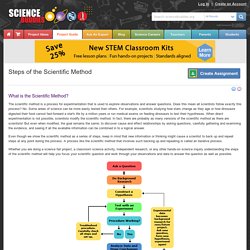
If you leave JavaScript disabled, you will only access a portion of the content we are providing. <a href="/science-fair-projects/javascript_help.php">Here's how. Procedure. [Types of Variables] [Activity #1] [Activity #2] [Activity #3] [Steps to Success] [Move Beyond] You're doing great!
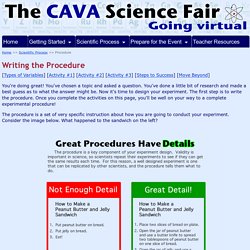
You've chosen a topic and asked a question. You've done a little bit of research and made a best guess as to what the answer might be. Now it's time to design your experiment. The first step is to write the procedure. The procedure is a set of very specific instruction about how you are going to conduct your experiment. Sadly, no one could eat the sandwich on the left. Variables Details also help to control variables in your experiment. Independent Variable The independent variable is the one that YOU choose to help you answer your question. If there's more than one independent variable, the experiment becomes flawed because you can't be sure what caused the changes you observed.
Activity #1: Start Thinking! The Venn Diagram of Irrational Nonsense. The curiously revered world of irrational nonsense has seeped into almost every aspect of modern society and is both complex and multifarious.

Therefore rather than attempt a comprehensive taxonomy, I have opted instead for a gross oversimplification and a rather pretty Venn Diagram. In my gross over simplification the vast majority of the multitude of evidenced-free beliefs at large in the world can be crudely classified into four basic sets or bollocks. Namely, Religion, Quackery, Pseudoscience and the Paranormal. However as such nonsensical beliefs continue to evolve they become more and more fanciful and eventually creep across the bollock borders.
Although all the items depicted on the diagram are completely bereft of any form of scientific credibility, those that successfully intersect the sets achieve new heights of implausibility and ridiculousness. sScienceMap. Understanding Science: An overview. To understand what science is, just look around you.
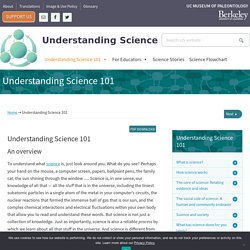
What do you see? Perhaps, your hand on the mouse, a computer screen, papers, ballpoint pens, the family cat, the sun shining through the window …. Science is, in one sense, our knowledge of all that — all the stuff that is in the universe: from the tiniest subatomic particles in a single atom of the metal in your computer's circuits, to the nuclear reactions that formed the immense ball of gas that is our sun, to the complex chemical interactions and electrical fluctuations within your own body that allow you to read and understand these words. Instructional Model - Argument-Driven Inquiry.
A manifesto for reproducible science : Nature Human Behaviour. How to quickly spot dodgy science. I haven’t got time for science, or at least not all of it.
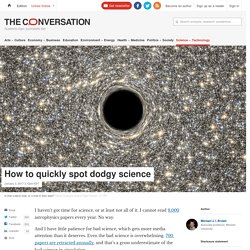
I cannot read 9,000 astrophysics papers every year. No way. And I have little patience for bad science, which gets more media attention than it deserves. Even the bad science is overwhelming. 700 papers are retracted annually, and that’s a gross underestimate of the bad science in circulation. I, like most scientists, filter what I read using a few tricks for quickly rejecting bad science. Okay, this looks bad. How we edit science part 1: the scientific method. We take science seriously at The Conversation and we work hard to report it accurately.
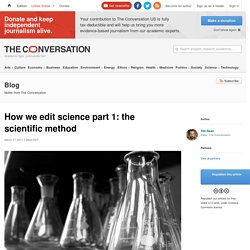
This series of five posts is adapted from an internal presentation on how to understand and edit science by our Australian Science & Technology Editor, Tim Dean. We thought you might also find it useful. Introduction If I told you that science was a truth-seeking endeavour that uses a single robust method to prove scientific facts about the world, steadily and inexorably driving towards objective truth, would you believe me?